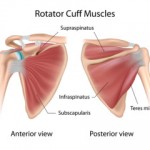Written by Ethan Baxter
The rotator cuff is made up of four muscles that help move and stabilize the shoulder joint. Damage to any or all of the four muscles and the ligaments that attach these muscles to bone can occur because of small injury, chronic overuse, or gradual aging. This damage can cause noticeable pain and disability with range of motion and use of the shoulder joint.
The four main muscles in the rotator cuff are:
- Supraspinatus
- Infraspinatus
- Subscapularis
- Teres minor.
These four muscles help move the rotator cuff whereas the tendons are what keep the ball in the socket for the most part.
The shoulder is a ball-socket joint that allows the arm to move in many directions. It is made up of the humeral head (the upper end of the bone of the upper arm) fitting into the glenoid fossa of the scapula (shoulder blade). The humeral head is kept in place by the joint capsule and labrum, thick bands of cartilage that form an elongated cone where the humeral head fits. The rotator cuff muscles are the dynamic stabilizers and movers of the shoulder joint and adjust the position of the humeral head and scapula during shoulder movement.
When the rotator cuff is damaged many issues can appear:
- Pain and spasm reduce the range of movement in the shoulder
- Swelling can occur due to build-up of fluid
- The muscles can’t make the small movements within the joints to move the shoulder in a fluid motion
The severity of the injury can range between a minor strain and inflammation to the muscle or tendon that won’t led to any long term effects, to a partial or complete tear and need surgery for repair. An inflamed rotator cuff could take 2-4 weeks to heal with the aid of ice and rest. Unfortunately, if you have torn your rotator cuff it will most likely need some sort of surgery to repair it.
Whether your rotator cuff was a minor strain or a complete rupture, physiotherapy can help to alleviate painful symptoms and help to rehabilitate the shoulder allowing you a swift return to function.




